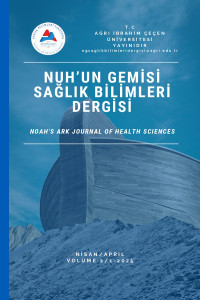Abstract
Virtual reality is a technology that involves users in a three-dimensional, interactive environment. This technology, supported by visual and audio components, is used in many fields from education to health. Virtual reality, first introduced in the 1960s, has become more accessible with technological developments. In the health sector, the areas of use for pain management, rehabilitation and education are increasing. It has been found to be effective in improving student skills, especially in midwifery education. Virtual reality is an innovative tool that increases student participation and motivation in midwifery education and improves cognitive learning and clinical competencies. It helps students prepare for real-world scenarios and helps them understand theoretical knowledge more effectively. The literature shows that virtual reality is more successful than traditional pedagogical methods. However, the integration of this technology into midwifery education requires adaptation of curricula and further research.
Keywords
References
- Addison, A Sueta, C. (2015). Editorial (Thematic Issue: The Life Cycle of the Heart Failure Patient). Current Cardiology Reviews, 11(1), 2-3.
- Aasekjær, K., Bjørnås, B., Skivenes, H. K., & Vik, E. S. (2024). Immersive virtual reality (VR) when learning anatomy in midwifery education: A pre-post pilot study. European Journal of Midwifery, 8, 10-18332. https://doi.org/10.18332/ejm/191364
- Alammary, M., Halliday, L., & Konstantinidis, S. (2023). 360-degree virtual reality utilising head-mounted devices in undergraduate nursing and midwifery education: a scoping review. Virtual Worlds, 2(4), 396-421. https://doi.org/10.3390/virtualworlds2040023
- Asadzadeh, A., Samad-Soltani, T., & Rezaei-Hachesu, P. (2021). Applications of virtual and augmented reality in infectious disease epidemics with a focus on the COVID-19 outbreak. Informatics in Medicine Unlocked, 24, 100579. https://doi.org/10.1016/j.imu.2021.100579
- Carus, E., Albayrak, N., Bildirici, H., & Gür-Özmen, S. (2022). Immersive virtual reality on childbirth experience for women: a randomized controlled trial. BMC Pregnancy and Childbirth, 22(1). https://doi.org/10.1186/s12884-022-04598-y
Abstract
Sanal gerçeklik, kullanıcıları üç boyutlu, etkileşimli bir ortama dahil eden bir teknolojidir. Görsel ve işitsel bileşenlerle desteklenen bu teknoloji, eğitimden sağlığa birçok alanda kullanılmaktadır. İlk olarak 1960’larda tanıtılan sanal gerçeklik, teknolojik gelişmelerle daha erişilebilir hale gelmiştir. Sağlık sektöründe, ağrı yönetimi, rehabilitasyon ve eğitim amaçlı kullanım alanları artmaktadır. Özellikle ebelik eğitiminde öğrenci becerilerini geliştirmek için etkili olduğu görülmüştür. Sanal gerçeklik, ebelik eğitiminde öğrenci katılımını ve motivasyonunu artıran, bilişsel öğrenmeyi ve klinik yetkinlikleri geliştiren yenilikçi bir araçtır. Öğrencilerin gerçek dünyadaki senaryolara hazırlanmasına yardımcı olurken, teorik bilgileri daha etkili anlamalarını sağlamaktadır. Literatür, sanal gerçekliğin geleneksel pedagojik yöntemlerden daha başarılı olduğunu göstermektedir. Ancak, bu teknolojinin ebelik eğitimine entegrasyonu için müfredatların uyarlanması ve daha fazla araştırma yapılması gerekmektedir.
Keywords
References
- Addison, A Sueta, C. (2015). Editorial (Thematic Issue: The Life Cycle of the Heart Failure Patient). Current Cardiology Reviews, 11(1), 2-3.
- Aasekjær, K., Bjørnås, B., Skivenes, H. K., & Vik, E. S. (2024). Immersive virtual reality (VR) when learning anatomy in midwifery education: A pre-post pilot study. European Journal of Midwifery, 8, 10-18332. https://doi.org/10.18332/ejm/191364
- Alammary, M., Halliday, L., & Konstantinidis, S. (2023). 360-degree virtual reality utilising head-mounted devices in undergraduate nursing and midwifery education: a scoping review. Virtual Worlds, 2(4), 396-421. https://doi.org/10.3390/virtualworlds2040023
- Asadzadeh, A., Samad-Soltani, T., & Rezaei-Hachesu, P. (2021). Applications of virtual and augmented reality in infectious disease epidemics with a focus on the COVID-19 outbreak. Informatics in Medicine Unlocked, 24, 100579. https://doi.org/10.1016/j.imu.2021.100579
- Carus, E., Albayrak, N., Bildirici, H., & Gür-Özmen, S. (2022). Immersive virtual reality on childbirth experience for women: a randomized controlled trial. BMC Pregnancy and Childbirth, 22(1). https://doi.org/10.1186/s12884-022-04598-y
Details
| Primary Language | Turkish |
|---|---|
| Subjects | Midwifery (Other) |
| Journal Section | Reviews |
| Authors | |
| Publication Date | April 30, 2025 |
| Submission Date | March 30, 2025 |
| Acceptance Date | April 22, 2025 |
| Published in Issue | Year 2025 Volume: 2 Issue: 1 |


